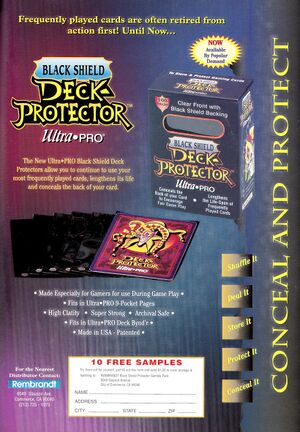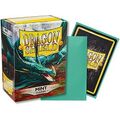Sleeve

A sleeve is a plastic protective cover for cards, that prevents scuffing. They can be sold in clear versions or with or opaque backs, in a range of colors, and can even have artwork on their backs.[1] Around 2011, 90% of cards in Magic: The Gathering constructed tournaments were sleeved.[2] Not long after, it became the common practice and sometimes even mandatory. Ultra Pro, the Japanese KMC, and Dragon Shield became the main sleeve producers. Good sleeves are acid free, and are not made of PVC.
History
Once collectible card games became popular after the advent of Magic: The Gathering, new technology was needed for two reasons. First, existing means of protection were not made with shuffling in mind: rigid top-loaders were effectively impossible to shuffle, and traditional card sleeves easily broke during shuffling. Card sleeves also became more important because of Magic tournaments: cards that were worn were considered to be marked, and could not be used in tournament decks.
In December 1995, Ultra Pro advertised the first card sleeves designed specifically for collectible card games, which they called deck protectors.[3] Deck protectors were a tougher and more uniform version of traditional card sleeves, made of polypropylene, and specifically designed to snugly fit traditional cards. The first deck protectors were clear on both sides, but soon after in April 1997, deck protectors were offered with opaque black backs, which would obscure the actual back of the card. Other colors soon followed[4], and now a wide variety of deck protectors are available in many colors, and even with images on the back.
KMC Sleeves USA is another company that has been active since 1995. They purchase from the KMC factory in Japan and sell the product to United States distributors and retailers. [5][6]
The Danish Dragon Shield brand joined the market in 2000. Dragon Shield sleeves have considerable heft in the plastic material that makes them about two to three times as thick as other premium card sleeves. The price is almost twice the price of other premium sleeves.
Around 2019, Ultimate Guard introduced their premium Katana Sleeves, manufactured in Japan. The Katanas are among the most expensive sleeves available.[7][8]
Quality issues
Early sleeves would have the quality control problem of all the sleeves in the packet not being all evenly cut. Despite other companies like KMC and Player's Choice (since 2010) bringing this issue under control, it is still a common problem with many card sleeve manufacturers.
Sleeve types
Penny sleeves
'Standard soft card sleeves' are the most cost efficient protection option for your MTG cards. They are also known as 'Penny sleeves' which they got from only costing a 'Penny' each.[9] Most 'penny' sleeves have a thickness of 30 up to 40 micron thick. They are considered the thinnest sleeves.[10] They are sold in packages of 100.
Penny sleeves tend to fit cards more loosely, and will generally have 2-3 mm slack on the sides of the cards. Penny sleeves are softer than regular sleeves, and so they are more difficult to shuffle due to the lack of a hard "edge" on the sleeve. They tend to get dirty very quickly and stick to each other.
Regular sleeves
Most 'regular' or 'premium' sleeves are about 100 microns thick. They are also known as 'deck sleeves' or 'outer sleeves'.
When product descriptions refer to “gloss” and “matte”, they are generally referring to the card display on sleeves (the clear side). Gloss sleeves are going to provide a clear, shiny display of the card, while matte is also clear, but less reflective. Matte sleeves are ideal for players who need a smooth shuffle experience, reduced glare, and long-lasting durability. Glossy sleeves are best for those who want vibrant artwork display and a sleek, shiny appearance.
Regular sleeves still have space between your card and the edge of the sleeve, which allows for the possibility of damage.
Tight-fit sleeves
Tight-Fit, Perfect Fit or inner sleeves provide an extra layer of protection by going over your cards and into a regular sleeve (double sleeving). They come in clear, smoke, top loading and side loading.
Top-loaders
The bulky "top-loader" is a rigid plastic case with one open end at the top (essentially a box for a single card).[11] Toploaders provide stiffness to your cards during storage and shipping. Valuable cards are typically placed in a thin penny sleeve and then in a toploader for maximum protection.
Other types
Ultra Pro also introduced sleeves for oversized cards.[12]
Double-sleeving
While single sleeving protects against general wear and tear, double sleeving makes your cards waterproof and nigh-indestructible. For this, two sleeves are used with the opening on opposite sides.[13][14][15] Double sleeving also protects cards from dirt specks, which can be a major problem if any happen to find their way inside of a single-sleeve. Double sleeving is also better for foils since it reduces the air flow around the card and helps prevent warping. Once you push the air out, shuffling is thought to be easier as well.
Rules
Playing with sleeves with artwork is permitted in all DCI official events, including all Premier Events. The Magic Tournament Rules also have parts regulating the permitted specification of artwork sleeves in non-regular REL events (which should have solid borders and had low reflection rate), and also giving Head Judge rights to disallow any sleeves which they decide as unsuitable for the event (for example, sleeves with scratches that make it possible to tell individual cards apart).
During the Booster Draft portion of Professional REL events (Spotlight Series, Pro Tours, and the World Championship), determined by the number (or lacking of) and opening frequency of double-faced cards of the set(s) used, Wizards of the Coast may announce the event is a pre-sleeved event (i.e. all cards will be pre-sleeved by staff before players "open the packs"); players may replace the provided sleeves with their own sleeves in matches once pool registration is finished in such events.[16]
Opaque sleeves
Opaque sleeves provide an advantage, they make older and newer card backs be indistinguishable and conceal minor damage of cards (which would otherwise be unplayable as they are considered to be marked). There are two conditions under which opaque sleeves must be used regardless of a card's condition:
- If a deck contains both Alpha and non-Alpha cards.
- If a deck contains double-faced cards and/or meld cards, and the "checklist cards" are not used.
Tournament rules
From the Tournament Rules (May 13, 2024—Outlaws of Thunder Junction)
- 3.11 Sleeves
Players may use plastic card sleeves or other protective devices on cards. If a player chooses to use card sleeves, all sleeves must be identical and all cards in their deck must be placed in the sleeves in an identical manner. If the sleeves feature holograms or other similar markings, cards must be inserted into the sleeves so these markings appear only on the faces of the cards.
During a match, a player may request that a judge inspect an opponent’s card sleeves. The judge may disallow the card sleeves if they believe they are marked, worn, or otherwise in a condition or of a design that interferes with shuffling or game play. In the interest of efficiency, the judge may choose to delay any change of sleeves until the end of the match.
Competitive and Professional Rules Enforcement Level tournaments impose additional restrictions on sleeves.
Highly reflective backs are not allowed. Sleeves with hologram patterns across some or all of the sleeve front or back are not allowed. Sleeves with artwork on their backs may be subjected to additional scrutiny, especially if there is no solid border around the edges.
When using sleeves on double-faced cards, sleeves must be completely opaque.
The Head Judge is the final authority on what sleeves are allowed.
Gallery
-
Ulta Pro clear
-
Ultra Pro matte
-
KMC
-
Dragon Shield
MTG Arena
In MTG Arena, card sleeves are optional cosmetic treatments that change the way the back of a card looks. Once a card sleeve is acquired, you can apply it to as many decks as you like. They have no effect on game play.[17]
Trivia
- Sleeves were first referred to in a card's rules text on the Mystery Booster 2 test card Plant a Sapling.
External links
- The first Magic sleeves. Old School MTG (september 25, 2020).
- Double Sleeved (April 18, 2023). "The Ultimate Double Sleeving Guide". doublesleeved.co.uk.
- Choosing The Best Trading Card Sleeves. Cardzreview.com (December 8, 2014).
References
- ↑ Tolarian Community College: Which Are The Best Card Sleeves?
- ↑ Mark Rosewater (August 29, 2011). "Every Two Sides Has a Story". magicthegathering.com. Wizards of the Coast. Archived from the original on 2017-11-23.
- ↑ Advertisement in The Duelist #8, December 1995
- ↑ Advertisement in The Duelist #19, October 1997
- ↑ Wizards Tower (March 2, 2028). "KMC Responds to Sleeve Concerns". Wizardtower.com.
- ↑ Andrew (August 16, 2023). "KMC Perfect Size Inner Sleeves Review". Doublesleeved.co.uk.
- ↑ Mitch Gross (January 20, 2020). "Standard Gaming Sleeves: Ultimate Guard’s Katana Review". Inkedgaming.com.
- ↑ Andrew (April 25, 2023). "Ultimate Guard Katana Sleeves Review - Are they a cut above the rest?". Doublesleeved.co.uk.
- ↑ Mike D (August 26, 2022). "Everything You Need To Know About Penny Sleeves (But Were Afraid To Ask)". Cardlines.com.
- ↑ Magic: The Gathering Trading Card Protection Guide. Cardbinder.com.
- ↑ A Top To Bottom Guide on Toploaders. Ultrapro.com.
- ↑ Magic Arcana (August 31, 2009). "Planechase Boxes and Sleeves". magicthegathering.com. Wizards of the Coast. Archived from the original on 2018-10-14.
- ↑ How To Double-Sleeve Your Magic: The Gathering Cards (AND WHY!) MTG (Video). Tolarian Community College. YouTube (2014).
- ↑ Single vs. Double Sleeving (Reddit)
- ↑ Pros and Cons to Double Sleeving (Reddit)
- ↑ Wizards of the Coast (May 25, 2016). "Double-Faced Cards Procedure for Professional REL Drafts". magicthegathering.com. Wizards of the Coast. Archived from the original on 2017-10-01.
- ↑ MTG Arena Admin (April, 2019). "Cosmetics FAQ". MTG Arena forums.



